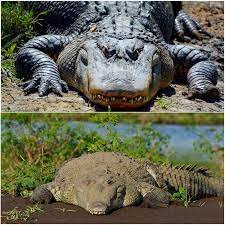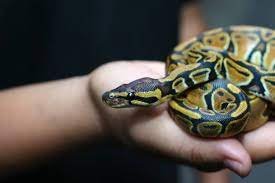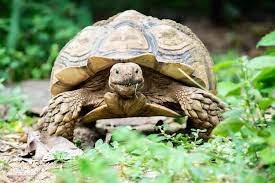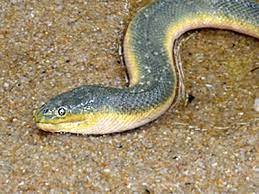The Leopard Gecko, so named for its distinctive leopard-like appearance and enormous fat-storage tail, is a stunningly unique lizard. There are several unusual habits and adorable vocalizations unique to geckos, who are otherwise cute placid, and friendly tiny reptiles. They get used to humans fast, and novice pet owners will find them easy to care for. This species, Eublepharis Macularius, is well-known for its characteristic tail-rattling behavior, which it displays in response to threats, during mating, and while hunting. The leopard gecko is often kept as a first reptile due to its low maintenance needs and ease of handling. They were born in countries such as Afghanistan, Pakistan, northwest India, and Iran. Leopard geckos are entertaining to observe because of their lively personalities and lively behaviors. They often have a yellow background with white spots and black markings; hatchlings start off with stripes and eventually develop into the spotted adult form. There are a number of patterned and/or colored morphs.
Typical leopard gecko appearance & behavior

Because of the spotted appearance of their backs, adult leopard geckos are known by that name.
Although many species of gecko lack eyelids, leopard geckos do not. They have the ability to close their eyes and blink even when asleep. Leopard geckos are equipped with a tail that can detach if they are captured by a predator, providing them valuable time to get away. Geckos are largely vocal creatures. While more noisy gecko species, leopard geckos have a short “bark” they utilize when upset.
Also, know 20 Friendly Pet Snakes For Beginners (and Choosing the Right One)
In times of hunger, when food is scarce, leopard geckos can draw on the fat stored in their tails.
Leopard geckos use tail wiggles for communication, mating, and territorial defence.
As opposed to the sticky pads found on the feet of most geckos, leopard geckos have sharp claws.
Native Habitat

There is a lizard called Eublepharis macularius, and it lives in semi-dry to arid deserts and on the fringes of forests from Northwest India to Pakistan, Iran, Iraq, and Afghanistan. In the desert scrub, they prefer to make their homes on the rocks. Many people are enamored with Leopard Geckos because of their distinct appearance; in fact, they go by numerous other names.
- Leopard geckos
- Toe-tailed geckos of the desert
- Geckoes with spotted, stubby tails
- The Geckos with the Flabby Tail
They are nocturnal lizards that blend in with the arid desert rocks or tall grasslands thanks to their leopard-print camouflage and incredible ability to avoid being eaten by predators.
Due to their ability to store energy in their tails, these animals can hide from predators for extended periods of time.
To avoid being tracked by predators, they shed their skin more regularly than other lizards.
Last but not least, the Leopard Gecko lets out a piercing yell. He makes chirping, barking, or hissing noises when he is mating, protecting himself, or getting agitated.
Feeding

A leopard gecko needs a diet that has a good balance of:
Worms and insects such as crickets, cockroaches, mealworms, super worms, hornworms, calci worms, and waxworms. Feed crickets that have recently been fed and are no bigger than the gecko’s eye socket. Geckos prefer hunting and catching live prey because it is more enjoyable and provides a higher nutritional value than freeze-dried insects.
Important Considerations for Leopard Gecko Nutrition

- Always have access to pure water.
- Provide young leopard geckos with food on a daily basis. The recommended feeding frequency for adults is once daily.
- The recommended dosage is one pinch of the multivitamin powder once a week, plus one pinch of the calcium supplement with vitamin D3 every other day.
- Give geckos only one or two insects at a time, and watch to see that they are devoured. If you share an environment with leopard geckos, you should never leave uneaten insects lying around.
- Animal-loving leopard geckos feast on insects. Live insects such as crickets, waxworms, mealworms (in moderation only), roaches, and super worms should be provided for them. Every time you feed your lizard, whether it’s a baby or an adult, be sure to sprinkle the insects with a calcium/D3 supplement that has been gut-loaded for at least 24 hours.
Care
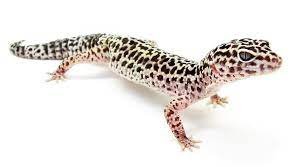
Geckos, especially young ones, can become overstimulated from repeated handling. Leopard geckos should not be handled frequently until they are at least 6 inches long, even if doing so helps them adjust to their new environments and their human caretakers. Catching them by the tail is a sure way to lose them. If a leopard gecko feels threatened or its tail is gripped too tightly, it can let go. There is a chance their tail will grow back, but it won’t look the same. It is normal for leopard geckos to shed their skin. Make sure they have access to humid hides and soaking dishes, and maintain an adequate humidity level in their habitat to facilitate healthy shedding.
Also
The Leopard Gecko: A Few Facts
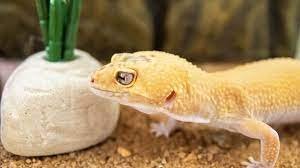
- The natural habitat of the Leopard gecko includes the central and southwestern regions of Asia as well as the eastern Mediterranean.
- Leos are not desert dwellers, so sand is not a good substrate for them, despite the fact that they are typically housed in terrariums that mimic desert environments.
- The Leopard Gecko, or Eublepharis Macularius as it is known by scientists, is a species of gecko.
- Despite popular belief, Leos are crepuscular creatures that are at their most active just before dawn.
- Leopard geckos are unable to climb vertical surfaces due to the absence of adhesive lamellae, which are microscopic hooks on their foot.
- Almost all leopard geckos for sale were likely born in a terrarium due to the ease with which they reproduce there.
- In its normal state, a Leopard gecko will appear a yellowish brown with dark dots covering its entire body. However, a wide variety of variants with extraordinary color variations were developed, and many of these have no spots at all.


